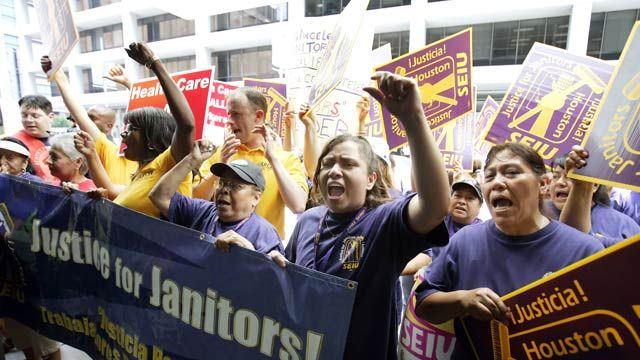Just last month, the federal minimum wage — currently at $7.25 an hour — celebrated its three-year anniversary. At that rate, a security guard, retail store clerk or nanny working full-time for minimum wage makes just $15,080 a year. That’s barely above the poverty line for a single person ($11,344) and far below it for a family of four ($22,314).
In this week’s episode, Sister Simone Campbell talks about our poverty crisis and her belief that we need to replace minimum wages with “living wages.” Sister Simone is not alone in advocating for the living wage concept. Economist Robert Pollin wrote his book, The Living Wage: Building a Fair Economy, in 2000. It chronicled the living wage campaigns that swept the country in the 1990s. At the time journalist Robert Kuttner, co-editor of The American Prospect , noted in a back-of-the-book blurb that “The living wage campaign is the most interesting (and under-reported) grassroots enterprise to emerge since the civil rights movement.”
We called Pollin to find out more about the concept and why it’s important not to sacrifice the welfare of workers in tough economic times.

Theresa Riley: What is a living wage?
Robert Pollin: Conceptually the idea of a living wage emerges out of social movements and thinking about what it takes for people to live a minimally decent life. There’s a great book by Lawrence Glickman – it’s called A Living Wage: American Workers and the Making of a Consumer Society– and he defines it as “a wage level that offers workers the ability to support families, to maintain self-respect, and to have both the means and the leisure to participate in the civic life of the nation.”
And if you’ve ever heard of Amartya Sen, an economist — he’s probably the most eminent living economist. And what made him eminent was he tried to focus on what we really mean when we talk about welfare and the well-being of people. Amartya Sen’s definition of what constituted welfare is almost identical to what Glickman defines as a living wage: the emphasis on self-respect, supporting your family, and being able to participate without shame in your community, that was really the point that Sen got to.
Theresa Riley: How is it typically calculated? I believe it’s different in different areas of the country, right?
Pollin: If we’re talking about what it takes to live at a minimally decent level to support a family and to participate in the community, it depends on the cost of living in any given community. (And, if we really want to get specific it depends on how many people you’re supporting, how many people are in a family, as well as the cost of living.) I’ve done research on that exact question and the biggest variable is the cost of housing in a community.
Let’s take for example Boston and Omaha, Nebraska. There’s going to be a very large disparity in the cost of housing, and so that would have to be reflected in the cost of a living wage. So there isn’t a single number, but I would say in today’s economy a decent number would be somewhere between 10 and 20 dollars an hour. If we have to pick one number as a minimally decent minimum wage, my colleague Jeannette Wicks-Lim came up with the number $12.40 an hour.
There is a point at which, if you raise the minimum wage enough, it will create problems in terms of employment. Businesses will start to think about whether to hire somebody, or start to think about laying off people.
Riley: How many cities have living wage ordinances?
Pollin: Many municipalities, over 140, have some kind of living wage measure. The fact is that states have taken some action to establish a higher standard, not as high as living wage standards in municipalities, but the coverage is much broader. Right now, 18 states plus the District of Columbia have minimum wage rates above the federal minimum, and the range is in between $7.40 an hour in Rhode Island to $9.04 in the state of Washington. The total number of people who are covered by minimum wages above the federal minimum is 134 million — that’s 43 percent of the population.
Riley: And for the municipality ordinances, is there a standard way of calculating based on all the factors that you mentioned earlier?
Pollin: I would say it’s kind of scattershot. When the living wage movement started in the mid-to-late 1990s, it wasn’t like there was any really systematic effort in determining what constituted a living wage in different communities. One of the interesting things in all the work that I did was just getting communities to talk about stuff like that. They hadn’t really thought about it.
I think the closest thing would be to say what is the poverty line for a family size and then maybe we should set the living wage at a level that puts people above the poverty line for at least a family of three, something like that. Now, the problem in doing that is that the poverty line itself is very low and really has not ever been refined since the time it was first established in the mid-1960s. Another simple complication is — what if you don’t have a family of three? What if you’re just working for yourself, what if you’re a teenager, and so what does the living wage mean for such a person? Should it be set in the same way? So these are the issues that unfortunately are unavoidable in trying to set this up.
Riley: In your new book, Back to Full Employment, you offer short- and long-term solutions for getting to four percent unemployment. Would a living wage fit into those recommendations, and what are the pros and cons of a higher minimum wage in this economy?
Pollin: When we talk about full employment, it has to be full employment at decent wages. Because the easiest thing to do is to get to full employment at terrible wages. That’s the approach where you eliminate the welfare state altogether and you tell people you’re on your own; people are desperate, and you can bargain down wages. So you can have a full employment economy at destitution level wages. I would consider a decent minimum wage around $12. It’s something we could establish without creating a lot of negative effects on job opportunities.


